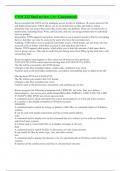Exam (elaborations)
CNM 232 final review || A+ Guaranteed.
- Course
- Institution
Know/recognize the NTFS use for managing access to files in Windows 10 correct answers File and folder permissions: NTFS allows you to set permissions on files and folders, which determine who can access them and what actions they can perform. There are several levels of permissions, including Read...
[Show more]



